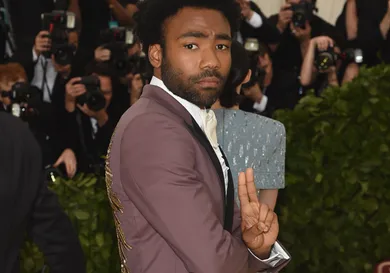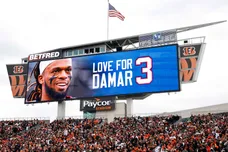During his hosting of “Saturday Night Live” this past weekend, Childish Gambino, a.k.a. Donald Glover, unveiled a new single titled “This Is America.” While his performance of the song provided insight into the mind of the articulate creative genius, it was the gripping music video released shortly thereafter that caught everyone off guard. Directed by Hiro Murai, who also directs Atlanta, the graphic visuals offer a thought-provoking and gut-wrenching commentary on the current state of America. The Afro-beat rhythm of the chorus contrasts with the aggressive and bass-heavy verses that dissect the reality of black culture versus how it's perceived. Visceral shifts between the two stages occur after moments of gun violence, with Glover being the sole perpetrator. It’s a vicious rinse-and-repeat cycle that highlights how willful ignorance is but a short term escape from the many problems plaguing the black community. It suggests that while we continue to turn a blind eye to such problems, they are swiftly catching up.
“This Is America” also delivers a stunning, if pessimistic, statement on the condition of the black entertainment industry. Rather than playing a passive role, Glover chooses to directly incriminate himself. Shirtless and disheveled, and with unkempt hair and beard, he appears crazed and wild looking. His manic behavior manifests itself in bizarre contortions of the body, as he twists and turns his way toward the camera. Suddenly, he strikes a grotesque pose, pulls out a gun, and shoots a hooded black man in the back of the head. One minute the victim is playing a soft guitar melody, and the next minute his lifeless body is being dragged away. He’s a faceless black man, vulnerable and unsuspecting. He doesn’t anticipate his fate, and the implication is that no one cares about what’s going to happen to him, particularly now that he’s gone. Glover proceeds without so much as a second glance, handing the murder weapon to a young boy who wipes it of fingerprints with a handkerchief and disappears. It’s a horrifying moment: the gun is treated with the utmost care while the victim is deemed disposable, perhaps signifying the cruelty of the criminal justice system or how it’s impossible to live a carefree life as a black person in America.
Yet there is little time to contemplate what has just occurred. Glover’s hypnotic dancing becomes an immediate distraction, drawing the eye and mind away from the gruesome execution. He’s there for nothing more than entertainment, quite literally dancing his way around the violence and injustice that remain trapped in the scenery. It’s so close that you can almost touch it, but at the same time it remains removed. Content with being the main attraction, Glover pays no heed to the background noise, even if it’s vastly more important. It’s unclear if his ignorance is conscious or unconscious, but it doesn’t matter; the point has been made. Just like the 24-hour news cycle, Glover only provides viewers with a superficial slice of the real story, as we quickly move from one tragedy to the next. Per the status quo, tangible issues are nonchalantly waved aside in lieu of entertainment. The ugly is unappealing and downright sickening; viewers would much rather focus on pretty pictures than have their untarnished bubble popped.
There is a momentary reprieve from the violence, as the camera pivots from Glover to a black gospel choir rhythmically swaying from side to side. But the deranged artist is not absent for long: he glides in and abruptly mows down the church singers in one fell swoop with an assault rifle. The viewer doesn’t know where the guns are coming from; they just appear, as if out of thin air. Once again, the weapon is hastily carried away, while the bodies are left in a bloody heap on the ground, reminiscent of the horrific night in Charleston. Glover’s dance moves remain the primary focus; a troupe of uniformed school children follow his lead. All the while, a sea of chaos is gleefully erupting on the edges of the screen: people riot and jump on top of cars; a lone individual falls from the railing above but quickly disappears in the hazy madness; spectators lounge on the balcony, capturing the event with their phones but doing nothing to stop it; and cars litter the warehouse, their doors wide open and hazard lights flashing. There’s even a shrouded figure on a pale horse, a possible Biblical reference that seems deliberate given the many intricacies of the video.
Glover’s indulgence of viral dance crazes and assured triplet flow about material items and social status serve to distract those who are wholly preoccupied by such matters. It’s a glaring critique of the hypocrisy of the black entertainment industry, which has long claimed and continues to glorify guns, drug abuse, and violence. These deep-seated issues are laying waste to black America, but no one wants to take responsibility. Stereotypes continue to be perpetuated, all for the sake of a predominantly white audience. Just like the guitar player from the opening scene, talented musicians go unnoticed while the industry pushes trends that result in artists becoming caricatures of black culture.
Perhaps worst of all, it’s normalized by the media to the extent that it’s become a system of mental slavery: you have to buy into it in order to be deemed profitable. Unnecessary material possessions, cursory aesthetics, and brands trap young artists, who feel the need to appear as outlandish and outwardly wealthy as possible, even if it means going broke. Young Thug’s brief musings in the refrain about his social media followers are a representation of constant self-promotion by any means necessary. You may pay to get in, but the house always wins: label executives and the media see blacks as “barcodes” that can be marketed and sold on a whim. Glover is making the point that blacks are bred for the entertainment industry under set conditions. And just like kenneled dogs, they’re imprisoned. It’s an unsettling comparison, but an accurate one nonetheless.
At this point, the tension of the video has reached a stifling climax; one has no clue if the eager youngsters in tow will be the next victims of a third act of gun violence. But Glover doesn’t need to go there for the viewer to know the truth. Just when you fear the worst, the music unexpectedly stops and everyone around him flees. He freezes, mimicking the stance of shooting a gun as if to emphasize the nuance to the displays of violence. The silence is deafening. It’s only after he reaches into his pocket and lights a joint that the music returns, this time with Glover emphatically dancing on the roof of a car while the camera fades out and pans to black. One would think that the nightmare would end there, but Glover has a final appearance to make. With eerie sirens ushering in the final shots, the terrified artist comes into focus, the whites of his eyes and gleaming teeth outlining his face as he races for his life. The outcome is left unknown, as is the reason for his flight. What is he trying to escape? Police violence? The industry? The mob that is closing in around him? The various issues at hand? He very well may be running out of fear that if he gets caught, he will simply be another victim of the system.
The vast ambiguity of “This Is America” continues to be analyzed from every angle. The truth that the music video offers is difficult to swallow, as viewers are forced to relive the public traumas of black America. There are spare moments to breathe before we are thrust right back into the racial reckoning and seemingly endless brutality that is tearing black lives apart. The videography is brilliant, characterized by precisely timed tracking shots that sync up with the violent progression of the song. Familiar ad libs, courtesy of Young Thug, BlocBoy JB, 21 Savage, Quavo, and Slim Jxmmi, are ambient voices that make for an even more jarring listening experience given the context. The celebratory intonations of “we just wanna party” and “we just want the money” are punctuated by repetitive reminders from Glover about the daily pain and anguish of the black community, and the ill-fated need to get your money before it’s too late. Yet it is Glover’s undeniable sense of guilt in painting a vivid and true picture of America that is most heartbreaking. James Baldwin said it best: "To be black and conscious in America is to be in a constant state of rage."







